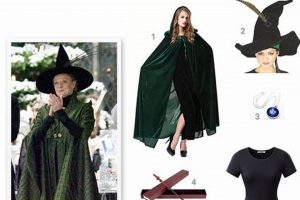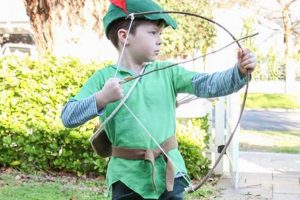Creating a historical Norse warrior ensemble independently allows for personalized expression and budgetary control. Constructing garments and accessories evocative of the Viking Age, such as tunics, trousers, cloaks, belts, and simulated weaponry, offers the opportunity to interpret historical accounts and artistic representations through a tangible medium.
This form of crafting fosters resourcefulness and creativity while providing a connection to historical narratives. Replicating attire and implements from this era enhances understanding of the materials, techniques, and societal values that shaped Viking culture. Furthermore, engaging in this type of project offers a unique approach to historical appreciation, diverging from conventional learning methods.
The subsequent sections will detail specific techniques for fabricating key components. This will encompass fabric selection, pattern adaptations, construction methods for clothing, and approaches to creating realistic-looking accessories. Guidance will also be provided on how to research and interpret historical sources for accurate representation.
Essential Considerations for Homemade Norse Warrior Garb
The following recommendations serve to guide the creation of historically inspired Viking Age attire, promoting authenticity and durability in the finished product.
Tip 1: Prioritize Natural Fiber Fabrics: Opt for materials such as linen, wool, and leather for clothing and accessories. These materials were prevalent during the Viking Age and provide both aesthetic accuracy and functional benefits, offering breathability and durability.
Tip 2: Employ Simple, Functional Designs: Viking clothing was characterized by practicality. Tunics, trousers, and cloaks should be constructed with basic patterns that allow for ease of movement and layering, reflecting the utilitarian nature of Norse attire.
Tip 3: Emphasize Hand-Sewn Details: While machine sewing may expedite construction, incorporate hand-sewn elements to enhance authenticity. Visible stitching using linen or wool thread adds a handcrafted aesthetic reflective of the era.
Tip 4: Ground Colors are Recommended: Choose dyes derived from natural sources if possible to create muted color palettes. Earth tones, such as browns, greens, and grays, are more historically plausible than bright, synthetic hues.
Tip 5: Accessorize with Functional Items: Belts, pouches, and simple jewelry, such as brooches made from brass or pewter, should be practical and understated. Avoid excessive ornamentation that is inconsistent with the Viking Age aesthetic.
Tip 6: Footwear Considerations: Leather boots or shoes, preferably ankle-height or higher, are essential. Opt for designs based on archaeological finds for increased accuracy and durability.
Tip 7: Focus on Fit and Comfort: Regardless of historical accuracy, ensure garments are comfortable and allow for a full range of motion. Functional and well-fitting attire is paramount, particularly for re-enactment activities or prolonged wear.
Adhering to these considerations will contribute to the creation of a convincing and durable ensemble. Authenticity combined with practicality will result in a garment that is both historically inspired and functional.
The subsequent section will address specific techniques in accessory crafting, detailing how to make belts, pouches, and simulated weaponry.
1. Authentic Fabric Selection
The selection of appropriate textiles is paramount in replicating a historical Norse warrior appearance. Fabric choice dictates not only the aesthetic accuracy of the representation but also impacts the garment’s functionality and durability. The use of materials consistent with those available during the Viking Age is crucial for achieving a believable portrayal.
- Linen for Underlayers
Linen served as a common fabric for undergarments and tunics due to its breathability and comfort. Archaeological evidence suggests its widespread use in Viking Age Scandinavia. Replicating this practice in a contemporary context requires sourcing appropriate linen weaves and weights, ensuring both comfort and historical accuracy.
- Wool for Outerwear
Wool offered warmth and water resistance, making it essential for outerwear such as cloaks and trousers. Different grades of wool provided varying levels of protection from the elements. Selecting suitable wool fabrics for a historical garment involves considering the weave density and fiber quality to match the protective needs and aesthetic of the intended design.
- Leather for Accents and Accessories
Leather was utilized for belts, footwear, and reinforcing garment edges. Its strength and durability made it a valuable resource. The selection of appropriate leather types, such as vegetable-tanned leather, and the use of period-accurate tanning techniques contribute to the authenticity of accessories and garment reinforcements.
- Natural Dye Considerations
The coloration of fabrics in the Viking Age relied primarily on natural dyes derived from plants and minerals. Replicating this requires understanding the available dye sources and mordanting techniques used to achieve specific colors. While modern synthetic dyes may offer convenience, the use of natural dyes enhances the overall historical fidelity of the garment.
The convergence of fabric selection, weaving techniques, and dyeing methods contributes to the successful creation of a visually accurate and functionally relevant Viking Age impression. By prioritizing these considerations, an individual can achieve a convincing and educational representation of Norse material culture.
2. Functional Garment Design
The practical considerations inherent in Norse attire dictated design elements for clothing crafted during the Viking Age. Replicating these garments necessitates a focus on functionality, ensuring the final product reflects the intended purpose of the original design.
- Tunic Length and Mobility
Tunics, the foundational garment, were typically designed to fall to the mid-thigh or knee, allowing for ease of movement during work or combat. This length facilitated activities such as farming, sailing, and warfare. Constructing a tunic with appropriate length and side slits is crucial for replicating this mobility in a functional Norse warrior ensemble.
- Trouser Construction and Reinforcement
Trousers, often constructed from wool or linen, required a robust design to withstand the rigors of daily life. Reinforcements at the knees and seat, alongside a practical method of fastening at the waist, were essential. These design elements ensured durability and comfort, a
llowing for unrestricted movement in demanding environments. - Cloak Fastenings and Protection
Cloaks provided vital protection against the elements. Their design prioritized ease of fastening and effective coverage. Using a brooch or simple tie, the cloak could be secured at the shoulder or chest, providing warmth and shielding the wearer from rain and wind. The size and shape of the cloak were also factors in maximizing its protective capabilities.
- Layering and Adaptability
The ability to layer garments was critical for adapting to varying weather conditions. Loose-fitting tunics and trousers allowed for the addition of underlayers for warmth or the removal of outerwear for ventilation. Designing garments with appropriate sizing and materials to facilitate layering is crucial for creating a versatile and functional Norse warrior outfit.
The aspects of tunic length, trouser construction, cloak fastenings, and layering underscore the importance of functional design in replicating Norse attire. The ability to create garments that emulate these practical considerations allows for a deeper understanding of Viking Age material culture.
3. Muted Color Palettes
The implementation of muted color palettes represents a key component in achieving a historically plausible Norse warrior representation. Evidence suggests that vibrant, synthetic colors were not readily available during the Viking Age. The cause-and-effect relationship is direct: an adherence to subdued, naturally derived hues enhances the authenticity of a self-made Viking Age ensemble, while the introduction of bright, anachronistic colors detracts from it. The importance of muted tones is rooted in accurately reflecting the dye technologies and available resources of the period. For example, garments discovered in archaeological sites often exhibit shades of brown, gray, and faded blues and greens, resulting from dyes extracted from plants, lichens, and minerals.
The practical significance of understanding this principle lies in its direct impact on the visual representation of the persona. If a homemade garment employs bright, modern dyes, the overall effect is immediately discordant, regardless of the accuracy of the garment’s cut or construction. Conversely, the careful selection of natural dyes, or the use of modern dyes in a manner that mimics the faded, weathered appearance of naturally dyed textiles, contributes significantly to the creation of a believable and immersive presentation. Experimentation with tea staining or deliberate fading techniques can further enhance the authentic appearance of modern fabrics.
In summary, the incorporation of muted color palettes is not merely an aesthetic preference but a critical element in achieving historical plausibility when constructing a Norse warrior outfit. Failing to acknowledge this can compromise the overall authenticity. While challenges may arise in sourcing or creating historically accurate dyes, the effort expended in achieving a subdued and natural color scheme greatly enhances the immersive quality of the finished ensemble. Furthermore, this understanding extends beyond mere visual representation; it promotes a deeper engagement with the technological and material constraints that shaped Viking Age society.
4. Period-Appropriate Accessories
The selection and construction of historically accurate accessories are integral to the convincing portrayal of a Norse warrior. These items, beyond mere ornamentation, contribute to the overall authenticity and provide valuable context to the constructed persona. Omission or misrepresentation of such accessories can significantly detract from the fidelity of a “diy viking costume”.
- Belts and Pouches
Belts, typically crafted from leather, served a functional purpose, securing clothing and providing attachment points for tools and pouches. Pouches, often made of leather or fabric, were utilized to carry essential items, such as coins, tinder, or small tools. The style of belt buckles and pouch closures should reflect archaeological finds from the Viking Age. For example, simple ring buckles or toggle closures are more appropriate than modern snap fasteners. A well-crafted belt and pouch set adds credibility to the overall impression.
- Brooches and Pins
Brooches and pins functioned as garment fasteners, particularly for cloaks and shawls. These items were often constructed from bronze, silver, or iron, and their designs frequently incorporated intricate knotwork or animal motifs. Replicating these brooches using casting or metalworking techniques, or sourcing reproductions based on archaeological examples, enhances the historical accuracy of the ensemble. Modern safety pins or other anachronistic fasteners should be avoided.
- Weaponry and Shields (Simulated)
While actual weapons are inappropriate and potentially illegal for most contexts, simulated weaponry can significantly contribute to a Norse warrior impression. Shields, typically constructed from wood and faced with leather or metal, were essential for defense. Simulated swords, axes, and spears can be crafted from wood or foam, prioritizing safety and realism. Detailing, such as the addition of simulated rivets or leather grips, further enhances the appearance of authenticity. It’s crucial to emphasize that these are non-functional representations intended for display or costuming purposes only.
- Jewelry (Simple and Understated)
While elaborate jewelry was not uncommon in Viking Age Scandinavia, everyday attire typically featured more understated pieces. Simple arm rings, finger rings, or pendants made from bronze, silver, or amber can add a subtle touch of authenticity. The designs should be based on historical examples, such as spiral arm rings or Thor’s hammer pendants. Excessive or anachronistic jewelry can detract from the overall impression.
The selection of period-appropriate accessories requires diligent research and careful execution. The attention to detail in these smaller items can significantly elevate the quality and believability of a self-assembled Norse warrior representation. Moreover, the process of crafting or acquiring these accessories provides a deeper understanding of the material culture and craftsmanship of the Viking Age.
5. Durable Construction Techniques
The long-term viability of any self-constructed Norse warrior ensemble hinges significantly on the implementation of robust construction methods. Durable construction is not merely an aesthetic consideration but a functional necessity for attire intended to withstand wear and tear, potential re-enactment activities, or prolonged use in diverse environments.
- Reinforced Seams for Longevity
Seam construction is paramount to garment integrity. Employing techniques such as flat-felled seams or double-stitched seams strengthens points of stress, mitigating the risk of seam failure under strain. Period-accurate seam finishes, while time-consuming, contribute to both durability an
d authenticity. For example, hand-felled seams, using linen or wool thread, provide superior strength compared to overlocked or serged edges, particularly in natural fiber fabrics. - Strategic Fabric Selection for Stress Points
Areas of garments subject to increased wear, such as elbows, knees, and shoulders, benefit from strategic fabric reinforcement. Utilizing heavier weight fabrics or incorporating additional layers of material in these zones enhances resistance to abrasion and tearing. This approach, observed in extant historical garments, extends the lifespan of the attire and reduces the likelihood of premature failure.
- Durable Fastening Methods
Fastenings, including buttons, toggles, and lacings, require robust construction to withstand repeated use. Securing these elements with strong stitching, reinforcement patches, or the use of durable materials such as bone, horn, or metal ensures their longevity. Weak or poorly attached fastenings can quickly compromise the functionality and aesthetic of the garment.
- Edge Finishing for Prevention of Fraying
Raw edges of fabric are susceptible to fraying, which can progressively degrade the garment’s structural integrity. Techniques such as hemming, binding, or the application of bias tape prevent fraying and maintain the garment’s shape. Period-appropriate edge finishes, such as hand-stitched hems or the use of woven braids, contribute to both durability and authenticity.
The adoption of durable construction methods, ranging from reinforced seams to strategic fabric selection, is essential for creating a self-made Norse warrior ensemble that withstands the test of time. Prioritizing these techniques ensures that the finished product is not only aesthetically pleasing but also functionally robust and representative of the enduring quality associated with Viking Age craftsmanship.
6. Historical Research Foundation
A comprehensive understanding of the Viking Age is fundamental to constructing a historically plausible “diy viking costume”. This knowledge base dictates the accuracy of garment design, material selection, and accessory replication, ensuring the final product reflects verifiable aspects of Norse culture.
- Archaeological Textile Analysis
Examination of excavated textile fragments provides direct evidence of fabric types, weave structures, and dyeing techniques employed during the Viking Age. This information informs material choices, guiding the selection of appropriate linens, wools, and other fabrics. Analysis reports reveal the prevalence of specific weaves, such as twill, and the use of natural dyes derived from plants and minerals. Ignoring this data can result in the utilization of anachronistic materials and colors, detracting from historical accuracy.
- Saga and Edda Interpretation
While not direct representations of clothing, Norse sagas and Eddic poems offer insights into societal norms and the symbolic significance of attire. References to specific garments, such as the kyrtill (tunic) or brk (trousers), provide contextual clues regarding their usage and social implications. These literary sources, however, require careful interpretation, acknowledging potential biases and narrative embellishments. When constructing a “diy viking costume”, saga references can inform design choices, but should be cross-referenced with archaeological evidence to ensure plausibility.
- Depictions in Norse Art
Pictorial representations on runestones, tapestries, and other artifacts offer visual depictions of clothing and accessories. While stylistic conventions may influence these depictions, they provide valuable information regarding garment silhouettes, decorative elements, and the inclusion of specific items, such as weapons or jewelry. The Oseberg tapestry fragments, for example, depict figures wearing long tunics and cloaks, providing visual evidence for garment construction. Caution must be exercised in interpreting these depictions, recognizing that artistic license may have influenced the portrayal of clothing.
- Comparative Ethnographic Studies
Examining the clothing traditions of contemporary or historically related cultures can offer supplementary insights into garment construction and usage. Analogies drawn from cultures with similar climates and social structures can provide plausible interpretations where direct evidence is lacking. However, this approach requires careful consideration of potential cultural differences and should not be used to supplant direct archaeological or textual evidence. Ethnographic studies can inform the construction of less-documented aspects of Norse attire, such as undergarments or headwear, but should be approached with appropriate caution.
The integration of these research facets is essential for creating a “diy viking costume” that transcends mere costume design and embodies a verifiable representation of Norse culture. Ignoring these foundational elements risks producing a superficial and historically inaccurate imitation.
7. Practical Footwear Options
Footwear represents a critical, often overlooked, component of a constructed Norse warrior persona. The selection of appropriate and functional footwear directly impacts the overall authenticity and practicality of a “diy viking costume.” Footwear choices must reflect both the historical availability of materials and the environmental conditions encountered by individuals during the Viking Age. Inappropriate footwear detracts from the overall impression, regardless of the accuracy of other elements. Examples of historically plausible footwear include leather shoes and boots constructed using turnshoe methods, replicating archaeological finds from sites such as Birka and Hedeby. These construction methods prioritize durability and comfort, essential for activities such as walking, working, or participating in re-enactments. The practical significance of understanding this connection lies in ensuring that the finished ensemble is not only visually convincing but also suitable for the intended activities.
Further analysis reveals the importance of considering the specific context for which the footwear is intended. A “diy viking costume” designed for indoor display may prioritize aesthetic accuracy over long-term wearability. Conversely, an ensemble intended for outdoor use or re-enactment activities necessitates footwear designed for durability and protection from the elements. Modern footwear disguised as period-appropriate examples often lacks the necessary support and construction to withstand prolonged use, leading to discomfort or potential injury. The use of modern Vibram soles on a turnshoe construction, while offering increased durability, introduces an anachronistic element. The ideal approach balances historical accuracy with practical considerations, perhaps utilizing hidden modern materials or construction techniques to enhance durability without compromising the overall aesthetic.
In conclusion, the selection of “Practical Footwear Options” is not merely an ancillary consideration but a crucial determinant of the overall success of a “diy viking costume”. Addressing the challenges inherent in balancing historical accuracy with modern comfort and dura
bility requires careful planning and execution. Recognition of this interconnection contributes significantly to creating a more believable and functional representation of Norse attire, thereby enhancing the wearer’s overall experience and promoting a more accurate understanding of Viking Age material culture.
Frequently Asked Questions
The following questions and answers address common inquiries and misconceptions regarding the construction of historically inspired Norse warrior attire.
Question 1: What constitutes a historically accurate “diy viking costume”?
A historically accurate Norse warrior ensemble incorporates materials, construction techniques, and design elements consistent with archaeological evidence and scholarly interpretations of the Viking Age. This encompasses fabric selection (linen, wool), garment design (tunics, trousers, cloaks), accessories (belts, brooches), and footwear (leather shoes, boots).
Question 2: What fabrics are most suitable for a “diy viking costume”?
Linen and wool are the primary fabrics recommended. Linen is appropriate for undergarments and lighter-weight tunics, while wool provides warmth and durability for outerwear, such as cloaks and trousers. The selection of appropriate weaves and weights is essential for achieving both historical accuracy and functional performance.
Question 3: How can authenticity be achieved in a “diy viking costume” while remaining within a budget?
Authenticity can be achieved through careful material selection and a focus on simple, functional designs. Prioritizing natural fiber fabrics, even in less expensive grades, and adhering to basic garment patterns minimizes costs without sacrificing historical plausibility. Second-hand materials and resourceful sourcing contribute to budgetary constraints.
Question 4: What are the most common mistakes to avoid when creating a “diy viking costume”?
Common errors include the use of anachronistic fabrics (e.g., synthetic blends), inaccurate garment designs (e.g., overly elaborate tunics), and the incorporation of ahistorical accessories (e.g., modern zippers or plastic buckles). Thorough research and adherence to verifiable historical evidence mitigate these risks.
Question 5: Are simulated weapons necessary for a “diy viking costume”?
Simulated weapons are not strictly required, but they can enhance the visual impact of a Norse warrior representation. If included, weapons must be constructed with safety as the primary concern, utilizing non-lethal materials such as wood or foam. Compliance with local regulations regarding weapon replicas is essential.
Question 6: How should one approach historical research for a “diy viking costume”?
Historical research should encompass archaeological reports, scholarly articles, museum collections, and reliable online resources. Cross-referencing information from multiple sources ensures accuracy and avoids perpetuating historical inaccuracies. A critical evaluation of source credibility is paramount.
The construction of a credible Norse warrior ensemble demands a combination of research, craftsmanship, and attention to detail. Authenticity is achievable through diligent effort and a commitment to historical accuracy.
The following section will provide advanced considerations for experienced crafters, addressing complex aspects of Viking Age attire and accessory construction.
Conclusion
The preceding exploration of crafting historical Norse warrior attire independently underscores the importance of research, material selection, and construction techniques. A successful “diy viking costume” demands a commitment to historical accuracy, prioritizing authentic fabrics, functional designs, and period-appropriate accessories. Durable construction methods ensure longevity, while a comprehensive research foundation validates design choices.
The creation of a plausible Norse warrior representation offers a unique opportunity to engage with history in a tangible and immersive manner. Further investigation into Viking Age material culture, experimentation with traditional crafts, and adherence to verifiable historical evidence will enhance the authenticity and educational value of constructed ensembles. Continued pursuit of knowledge and refinement of technique will contribute to a more nuanced understanding of this fascinating era.






![Easy DIY Police Costumes: Tips & Ideas [Budget-Friendly] The DIY Hub: Creative Crafts, Repairs & Life Hacks Easy DIY Police Costumes: Tips & Ideas [Budget-Friendly] | The DIY Hub: Creative Crafts, Repairs & Life Hacks](https://craftingdiycenter.com/wp-content/uploads/2025/07/th-7319-300x200.jpg)
